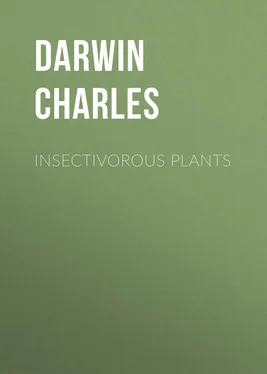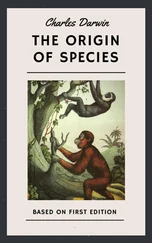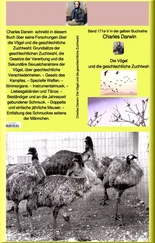Charles Darwin - Insectivorous Plants
Здесь есть возможность читать онлайн «Charles Darwin - Insectivorous Plants» — ознакомительный отрывок электронной книги совершенно бесплатно, а после прочтения отрывка купить полную версию. В некоторых случаях можно слушать аудио, скачать через торрент в формате fb2 и присутствует краткое содержание. Жанр: foreign_antique, foreign_prose, на английском языке. Описание произведения, (предисловие) а так же отзывы посетителей доступны на портале библиотеки ЛибКат.
- Название:Insectivorous Plants
- Автор:
- Жанр:
- Год:неизвестен
- ISBN:нет данных
- Рейтинг книги:5 / 5. Голосов: 1
-
Избранное:Добавить в избранное
- Отзывы:
-
Ваша оценка:
- 100
- 1
- 2
- 3
- 4
- 5
Insectivorous Plants: краткое содержание, описание и аннотация
Предлагаем к чтению аннотацию, описание, краткое содержание или предисловие (зависит от того, что написал сам автор книги «Insectivorous Plants»). Если вы не нашли необходимую информацию о книге — напишите в комментариях, мы постараемся отыскать её.
Insectivorous Plants — читать онлайн ознакомительный отрывок
Ниже представлен текст книги, разбитый по страницам. Система сохранения места последней прочитанной страницы, позволяет с удобством читать онлайн бесплатно книгу «Insectivorous Plants», без необходимости каждый раз заново искать на чём Вы остановились. Поставьте закладку, и сможете в любой момент перейти на страницу, на которой закончили чтение.
Интервал:
Закладка:
Small cubes of hard casein, moistened with water, were placed on two leaves; after three days one cube had its angles a little rounded, and after seven days both consisted of rounded softened masses, in the midst of much viscid and acid secretion; but it must not be inferred from this fact that the angles were dissolved, for cubes immersed in water were similarly acted on. After nine days these leaves began to re-expand, but in this and other cases the casein did not appear, as far as could be judged by the eye, much, if at all, reduced in bulk. According to Hoppe-Seyler and Lubavin 27 27 Dr. Lauder Brunton, 'Handbook for Phys. Lab.' p. 529.
casein consists of an albuminous, with a non-albuminous, substance; and the absorption of a very small quantity of the former would excite the leaves, and yet not decrease the casein to a perceptible degree. Schiff asserts 28 28 'Leons' &c. tom. ii. page 153.
– and this is an important fact for us – that "la casine purifie des chemistes est un corps presque compltement inattaquable par le suc gastrique." So that here we have another point of accordance between the secretion of Drosera and gastric juice, as both act so differently on the fresh casein of milk, and on that prepared by chemists.
A few trials were made with cheese; cubes of 1/20 of an inch (1.27 mm.) were placed on four leaves, and these after one or two days became well inflected, their glands pouring forth much acid secretion. After five days they began to re-expand, but one died, and some of the glands on the other leaves were injured. Judging by the eye, the softened and subsided masses of cheese, left on the discs, were very little or not at all reduced in bulk. We may, however, infer from the time during which the tentacles remained inflected, – from the changed colour of some of the glands, – and from the injury done to others, that matter had been absorbed from the cheese.
Legumin. – I did not procure this substance in a separate state; but there can hardly be a doubt that it would be easily digested, judging from the powerful effect produced by drops of a decoction of green peas, as described in the last chapter. Thin slices of a dried pea, after being soaked in water, were placed on two leaves; these became somewhat inflected in the course of a single hour, and most strongly so in 21 hrs. They re-expanded after three or four days.
The slices were not liquefied, for the walls of the cells, composed of cellulose, are not in the least acted on by the secretion.
Pollen. – A little fresh pollen from the common pea was placed on the discs of five leaves, which soon became closely inflected, and remained so for two or three days.
The grains being then removed, and examined under the microscope, were found discoloured, with the oil-globules remarkably aggregated. Many had their contents much shrunk, and some were almost empty. In only a few cases were the pollen-tubes emitted. There could be no doubt that the secretion had penetrated the outer coats of the grains, and had partially digested their contents. So it must be with the gastric juice of the insects which feed on pollen, without masticating it. 29 29 Mr. A.W. Bennett found the undigested coats of the grains in the intestinal canal of pollen-eating Diptera; see 'Journal of Hort. Soc. of London,' vol. iv. 1874, p. 158. Watts' 'Dict. of Chemistry,' vol. ii. 1872, p. 873.
Drosera in a state of nature cannot fail to profit to a certain extent by this power of digesting pollen, as innumerable grains from the carices, grasses, rumices, fir-trees, and other wind-fertilised plants, which commonly grow in the same neighbourhood, will be inevitably caught by the viscid secretion surrounding the many glands.
Gluten. – This substance is composed of two albuminoids, one soluble, the other insoluble in alcohol. Some was prepared by merely washing wheaten flour in water. A provisional trial was made with rather large pieces placed on two leaves; these, after 21 hrs., were closely inflected, and remained so for four days, when one was killed and the other had its glands extremely blackened, but was not afterwards observed.
Smaller bits were placed on two leaves; these were only slightly inflected in two days, but afterwards became much more so. Their secretion was not so strongly acid as that of leaves excited by casein. The bits of gluten, after lying for three days on the leaves, were more transparent than other bits left for the same time in water. After seven days both leaves re-expanded, but the gluten seemed hardly at all reduced in bulk. The glands which had been in contact with it were extremely black. Still smaller bits of half putrid gluten were now tried on two leaves; these were well inflected in 24 hrs., and thoroughly in four days, the glands in contact being much blackened. After five days one leaf began to re-expand, and after eight days both were fully re-expanded, some gluten being still left on their discs. Four little chips of dried gluten, just dipped in water, were next tried, and these acted rather differently from fresh gluten. One leaf was almost fully re-expanded in three days, and the other three leaves in four days. The chips were greatly softened, almost liquefied, but not nearly all dissolved. The glands which had been in contact with them, instead of being much blackened, were of a very pale colour, and many of them were evidently killed.
Конец ознакомительного фрагмента.
Текст предоставлен ООО «ЛитРес».
Прочитайте эту книгу целиком, купив полную легальную версию на ЛитРес.
Безопасно оплатить книгу можно банковской картой Visa, MasterCard, Maestro, со счета мобильного телефона, с платежного терминала, в салоне МТС или Связной, через PayPal, WebMoney, Яндекс.Деньги, QIWI Кошелек, бонусными картами или другим удобным Вам способом.
1
As Dr. Nitschke has given ('Bot. Zeitung,' 1860, p. 229) the bibliography of Drosera, I need not here go into details. Most of the notices published before 1860 are brief and unimportant. The oldest paper seems to have been one of the most valuable, namely, by Dr. Roth, in 1782. There is also an interesting though short account of the habits of Drosera by Dr. Milde, in the 'Bot. Zeitung,' 1852, p. 540. In 1855, in the 'Annales des Sc. nat. bot.' tom. iii. pp. 297 and 304, MM. Groenland and Trcul each published papers, with figures, on the structure of the leaves; but M. Trcul went so far as to doubt whether they possessed any power of movement. Dr. Nitschke's papers in the 'Bot. Zeitung' for 1860 and 1861 are by far the most important ones which have been published, both on the habits and structure of this plant; and I shall frequently have occasion to quote from them. His discussions on several points, for instance on the transmission of an excitement from one part of the leaf to another, are excellent. On December 11, 1862, Mr. J. Scott read a paper before the Botanical Society of Edinburgh, [] which was published in the 'Gardeners' Chronicle,' 1863, p. 30. Mr. Scott shows that gentle irritation of the hairs, as well as insects placed on the disc of the leaf, cause the hairs to bend inwards. Mr. A.W. Bennett also gave another interesting account of the movements of the leaves before the British Association for 1873. In this same year Dr. Warming published an essay, in which he describes the structure of the so-called hairs, entitled, "Sur la Diffrence entre les Trichomes," &c., extracted from the proceedings of the Soc. d'Hist. Nat. de Copenhague. I shall also have occasion hereafter to refer to a paper by Mrs. Treat, of New Jersey, on some American species of Drosera. Dr. Burdon Sanderson delivered a lecture on Dionaea, before the Royal Institution published in 'Nature,' June 14, 1874, in which a short account of my observations on the power of true digestion possessed by Drosera and Dionaea first appeared. Prof. Asa Gray has done good service by calling attention to Drosera, and to other plants having similar habits, in 'The Nation' (1874, pp. 261 and 232), and in other publications. Dr. Hooker, also, in his important address on Carnivorous Plants (Brit. Assoc., Belfast, 1874), has given a history of the subject.
Читать дальшеИнтервал:
Закладка:
Похожие книги на «Insectivorous Plants»
Представляем Вашему вниманию похожие книги на «Insectivorous Plants» списком для выбора. Мы отобрали схожую по названию и смыслу литературу в надежде предоставить читателям больше вариантов отыскать новые, интересные, ещё непрочитанные произведения.
Обсуждение, отзывы о книге «Insectivorous Plants» и просто собственные мнения читателей. Оставьте ваши комментарии, напишите, что Вы думаете о произведении, его смысле или главных героях. Укажите что конкретно понравилось, а что нет, и почему Вы так считаете.












